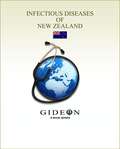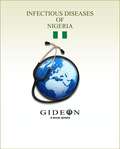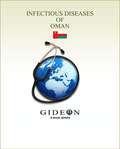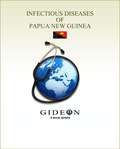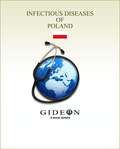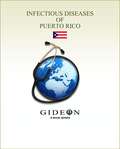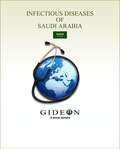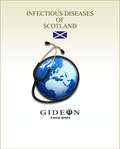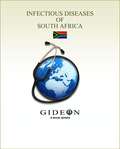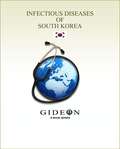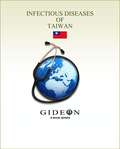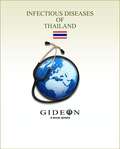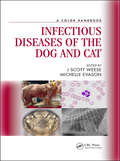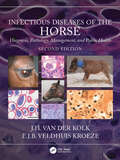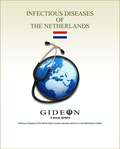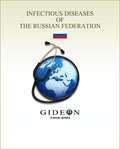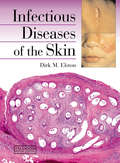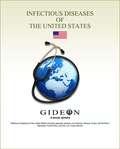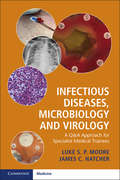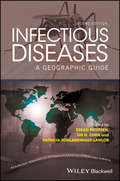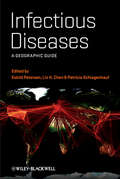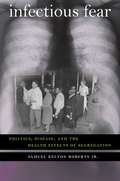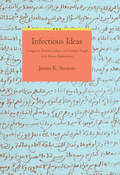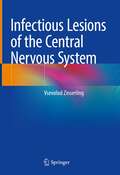- Table View
- List View
Infectious Diseases of New Zealand 2010 edition
by Dr Stephen Berger Gideon InformaticsInfectious Diseases of New Zealand is one in a series of GIDEON ebooks which summarize the status of individual infectious diseases, in every country of the world. Data are based on the GIDEON web application (www.gideononline.com) which relies on standard text books, peer-review journals, Health Ministry reports and ProMED, supplemented by an ongoing search of the medical literature. Chapters are arranged alphabetically, by disease name. Each section is divided into four sections: 1. Descriptive epidemiology2. Summary of clinical features3. Status of the disease in New Zealand4. References There are 347 generic infectious diseases in the world today. 188 of these are endemic, or potentially endemic, to New Zealand. A number of other diseases are not relevant to New Zealand and have not been included in this book. In addition to endemic diseases, all published data regarding imported diseases and infection among expatriates from New Zealand are included.
Infectious Diseases of Nigeria 2010 edition
by Dr Stephen Berger Gideon InformaticsInfectious Diseases of Nigeria is one in a series of GIDEON ebooks which summarize the status of individual infectious diseases, in every country of the world. Data are based on the GIDEON web application (www.gideononline.com) which relies on standard text books, peer-review journals, Health Ministry reports and ProMED, supplemented by an ongoing search of the medical literature. Chapters are arranged alphabetically, by disease name. Each section is divided into four sections: 1. Descriptive epidemiology2. Summary of clinical features3. Status of the disease in Nigeria4. References There are 347 generic infectious diseases in the world today. 239 of these are endemic, or potentially endemic, to Nigeria. A number of other diseases are not relevant to Nigeria and have not been included in this book. In addition to endemic diseases, all published data regarding imported diseases and infection among expatriates from Nigeria are included.
Infectious Diseases of Oman 2010 edition
by Dr Stephen Berger Gideon InformaticsInfectious Diseases of Oman is one in a series of GIDEON ebooks which summarize the status of individual infectious diseases, in every country of the world. Data are based on the GIDEON web application (www.gideononline.com) which relies on standard text books, peer-review journals, Health Ministry reports and ProMED, supplemented by an ongoing search of the medical literature. Chapters are arranged alphabetically, by disease name. Each section is divided into four sections: 1. Descriptive epidemiology2. Summary of clinical features3. Status of the disease in Oman4. References There are 347 generic infectious diseases in the world today. 197 of these are endemic, or potentially endemic, to Oman. A number of other diseases are not relevant to Oman and have not been included in this book. In addition to endemic diseases, all published data regarding imported diseases and infection among expatriates from Oman are included.
Infectious Diseases of Papua New Guinea 2010 edition
by Dr Stephen Berger Gideon InformaticsInfectious Diseases of Papua New Guinea is one in a series of GIDEON ebooks which summarize the status of individual infectious diseases, in every country of the world. Data are based on the GIDEON web application (www.gideononline.com) which relies on standard text books, peer-review journals, Health Ministry reports and ProMED, supplemented by an ongoing search of the medical literature. Chapters are arranged alphabetically, by disease name. Each section is divided into four sections: 1. Descriptive epidemiology2. Summary of clinical features3. Status of the disease in Papua New Guinea4. References There are 347 generic infectious diseases in the world today. 206 of these are endemic, or potentially endemic, to Papua New Guinea. A number of other diseases are not relevant to Papua New Guinea and have not been included in this book. In addition to endemic diseases, all published data regarding imported diseases and infection among expatriates from Papua New Guinea are included.
Infectious Diseases of Poland 2010 edition
by Dr Stephen Berger Gideon InformaticsInfectious Diseases of Poland is one in a series of GIDEON ebooks which summarize the status of individual infectious diseases, in every country of the world. Data are based on the GIDEON web application (www.gideononline.com) which relies on standard text books, peer-review journals, Health Ministry reports and ProMED, supplemented by an ongoing search of the medical literature. Chapters are arranged alphabetically, by disease name. Each section is divided into four sections: 1. Descriptive epidemiology2. Summary of clinical features3. Status of the disease in Poland4. References There are 347 generic infectious diseases in the world today. 199 of these are endemic, or potentially endemic, to Poland. A number of other diseases are not relevant to Poland and have not been included in this book. In addition to endemic diseases, all published data regarding imported diseases and infection among expatriates from Poland are included.
Infectious Diseases of Puerto Rico 2010 edition
by Dr Stephen Berger Gideon InformaticsInfectious Diseases of Puerto Rico is one in a series of GIDEON ebooks which summarize the status of individual infectious diseases, in every country of the world. Data are based on the GIDEON web application (www.gideononline.com) which relies on standard text books, peer-review journals, Health Ministry reports and ProMED, supplemented by an ongoing search of the medical literature. Chapters are arranged alphabetically, by disease name. Each section is divided into four sections: 1. Descriptive epidemiology2. Summary of clinical features3. Status of the disease in Puerto Rico4. References There are 347 generic infectious diseases in the world today. 197 of these are endemic, or potentially endemic, to Puerto Rico. A number of other diseases are not relevant to Puerto Rico and have not been included in this book. In addition to endemic diseases, all published data regarding imported diseases and infection among expatriates from Puerto Rico are included.
Infectious Diseases of Saudi Arabia 2010 edition
by Dr Stephen Berger Gideon InformaticsInfectious Diseases of Saudi Arabia is one in a series of GIDEON ebooks which summarize the status of individual infectious diseases, in every country of the world. Data are based on the GIDEON web application (www.gideononline.com) which relies on standard text books, peer-review journals, Health Ministry reports and ProMED, supplemented by an ongoing search of the medical literature. Chapters are arranged alphabetically, by disease name. Each section is divided into four sections: 1. Descriptive epidemiology2. Summary of clinical features3. Status of the disease in Saudi Arabia4. References There are 347 generic infectious diseases in the world today. 207 of these are endemic, or potentially endemic, to Saudi Arabia. A number of other diseases are not relevant to Saudi Arabia and have not been included in this book. In addition to endemic diseases, all published data regarding imported diseases and infection among expatriates from Saudi Arabia are included.
Infectious Diseases of Scotland 2010 edition
by Dr Stephen Berger Gideon InformaticsInfectious Diseases of Scotland is one in a series of GIDEON ebooks which summarize the status of individual infectious diseases, in every country of the world. Data are based on the GIDEON web application (www.gideononline.com) which relies on standard text books, peer-review journals, Health Ministry reports and ProMED, supplemented by an ongoing search of the medical literature. Chapters are arranged alphabetically, by disease name. Each section is divided into four sections: 1. Descriptive epidemiology2. Summary of clinical features3. Status of the disease in Scotland4. References There are 347 generic infectious diseases in the world today. 197 of these are endemic, or potentially endemic, to Scotland. A number of other diseases are not relevant to Scotland and have not been included in this book. In addition to endemic diseases, all published data regarding imported diseases and infection among expatriates from Scotland are included.
Infectious Diseases of South Africa 2010 edition
by Dr Stephen Berger Gideon InformaticsInfectious Diseases of South Africa is one in a series of GIDEON ebooks which summarize the status of individual infectious diseases, in every country of the world. Data are based on the GIDEON web application (www.gideononline.com) which relies on standard text books, peer-review journals, Health Ministry reports and ProMED, supplemented by an ongoing search of the medical literature. Chapters are arranged alphabetically, by disease name. Each section is divided into four sections: 1. Descriptive epidemiology2. Summary of clinical features3. Status of the disease in South Africa4. References There are 347 generic infectious diseases in the world today. 225 of these are endemic, or potentially endemic, to South Africa. A number of other diseases are not relevant to South Africa and have not been included in this book. In addition to endemic diseases, all published data regarding imported diseases and infection among expatriates from South Africa are included.
Infectious Diseases of South Korea 2010 edition
by Dr Stephen Berger Gideon InformaticsInfectious Diseases of South Korea is one in a series of GIDEON ebooks which summarize the status of individual infectious diseases, in every country of the world. Data are based on the GIDEON web application (www.gideononline.com) which relies on standard text books, peer-review journals, Health Ministry reports and ProMED, supplemented by an ongoing search of the medical literature. Chapters are arranged alphabetically, by disease name. Each section is divided into four sections: 1. Descriptive epidemiology2. Summary of clinical features3. Status of the disease in South Korea4. References There are 347 generic infectious diseases in the world today. 217 of these are endemic, or potentially endemic, to South Korea. A number of other diseases are not relevant to South Korea and have not been included in this book. In addition to endemic diseases, all published data regarding imported diseases and infection among expatriates from South Korea are included.
Infectious Diseases of Taiwan 2010 edition
by Dr Stephen Berger Gideon InformaticsInfectious Diseases of Taiwan is one in a series of GIDEON ebooks which summarize the status of individual infectious diseases, in every country of the world. Data are based on the GIDEON web application (www.gideononline.com) which relies on standard text books, peer-review journals, Health Ministry reports and ProMED, supplemented by an ongoing search of the medical literature. Chapters are arranged alphabetically, by disease name. Each section is divided into four sections: 1. Descriptive epidemiology2. Summary of clinical features3. Status of the disease in Taiwan4. References There are 347 generic infectious diseases in the world today. 212 of these are endemic, or potentially endemic, to Taiwan. A number of other diseases are not relevant to Taiwan and have not been included in this book. In addition to endemic diseases, all published data regarding imported diseases and infection among expatriates from Taiwan are included.
Infectious Diseases of Thailand 2010 edition
by Dr Stephen Berger Gideon InformaticsInfectious Diseases of Thailand is one in a series of GIDEON ebooks which summarize the status of individual infectious diseases, in every country of the world. Data are based on the GIDEON web application (www.gideononline.com) which relies on standard text books, peer-review journals, Health Ministry reports and ProMED, supplemented by an ongoing search of the medical literature. Chapters are arranged alphabetically, by disease name. Each section is divided into four sections: 1. Descriptive epidemiology2. Summary of clinical features3. Status of the disease in Thailand4. References There are 347 generic infectious diseases in the world today. 234 of these are endemic, or potentially endemic, to Thailand. A number of other diseases are not relevant to Thailand and have not been included in this book. In addition to endemic diseases, all published data regarding imported diseases and infection among expatriates from Thailand are included.
Infectious Diseases of Wild Mammals and Birds in Europe
by Anna Meredith J. Paul Duff Dolorés Gavier-WidenInfectious Diseases of Wild Mammals and Birds in Europe is a key resource on the diagnosis and treatment of infectious diseases in European wildlife that covers the distinctive nature of diseases as they occur in Europe, including strains, insect vectors, reservoir species, and climate, as well as geographical distribution of the diseases and European regulations for reporting, diagnosis and control. Divided into sections on viral infections, bacterial infections, fungal and yeast infections, and prion infections, this definitive reference provides valuable information on disease classification and properties, causative agents, epidemiology, pathogenesis, and implications for human, domestic and wild animal health.Key features:* Brings together extensive research from many different disciplines into one integrated and highly useful definitive reference.* Zoonotic risks to human health, as well as risks to pets and livestock are highlighted.* Each disease is covered separately with practical information on the animal species in which the disease has been recorded, clinical signs of the disease, diagnostic methods, and recommended treatments and vaccination.* Wildlife vaccination and disease surveillance techniques are described.* Examines factors important in the spread of disease such as changing climate, the movement of animals through trade, and relaxations in the control of wide animal populations.
Infectious Diseases of the Dog and Cat: A Color Handbook
This is a concise and quick reference guide, clinically oriented, based on experience underpinned by published research data. The systems-based approach emphasizes the problem list process utilized by most practitioners when faced with a patient presenting with a single or variety of clinical symptoms. This allows generation of a complete list of infectious disease differentials, and the ability to include or exclude those indicated based on patient risk assessment. Pathogen specific information enables rational choice of diagnostics, therapy, and prognostication for a complete list of small animal infectious disease that includes bacterial, viral, parasitic/protozoal and fungal.
Infectious Diseases of the Horse: Diagnosis, pathology, management, and public health
by J.H. van der Kolk E.J.B. Veldhuis KroezeA clinician and a pathologist collaborate to create a comprehensive yet practical book about established infectious diseases of horses, categorised according to the different pathogens. The book evaluates the latest diagnostic aids, including rapid developments in molecular biology, while emphasising that they are no substitute for clinical observation and skills. The majority of equine infectious diseases caused by microbes and parasites are covered - bacterial, viral, protozoan, fungal, ectoparasitic and helminthic. Practical appendices contain a list of differential diagnoses based on clinical signs to support clinical decision-making, a list of zoonoses and reportable diseases, and an elaborate illustrated appendix on clinical pathology and haematology. Thoroughly updated a decade after the release of the original text, the book continues to be concise and easy to understand and remains an important resource for uncommon conditions. It adds new sections on pythiosis, equine encephalosis/Peruvian horse sickness virus, Acinetobacter baumanii, enteric coronavirus-induced disease, and viral hepatitis, as well as updated nomenclature according to the latest reference databases. The most dynamic changes in veterinary medicine concern the development of new molecular diagnostic techniques and therapies, and these have been updated with most recent references throughout this second edition. Finally, the exceptional, full-colour clinical and microscopic images are showcased in a larger format. Infectious Diseases of the Horse is a valuable resource for all veterinary practitioners, scientists, pathologists, students, technicians and nurses working with horses.
Infectious Diseases of the Netherlands 2010 edition
by Dr Stephen Berger Gideon InformaticsInfectious Diseases of the Netherlands is one in a series of GIDEON ebooks which summarize the status of individual infectious diseases, in every country of the world. Data are based on the GIDEON web application (www.gideononline.com) which relies on standard text books, peer-review journals, Health Ministry reports and ProMED, supplemented by an ongoing search of the medical literature. Chapters are arranged alphabetically, by disease name. Each section is divided into four sections: 1. Descriptive epidemiology2. Summary of clinical features3. Status of the disease in the Netherlands4. References There are 347 generic infectious diseases in the world today. 196 of these are endemic, or potentially endemic, to the Netherlands. A number of other diseases are not relevant to the Netherlands and have not been included in this book. The Netherlands disease notes include separate sections on the Netherlands Antilles. In addition to endemic diseases, all published data regarding imported diseases and infection among expatriates from the Netherlands are included.
Infectious Diseases of the Russian Federation 2010 edition
by Dr Stephen Berger Gideon InformaticsInfectious Diseases of the Russian Federation is one in a series of GIDEON ebooks which summarize the status of individual infectious diseases, in every country of the world. Data are based on the GIDEON web application (www.gideononline.com) which relies on standard text books, peer-review journals, Health Ministry reports and ProMED, supplemented by an ongoing search of the medical literature. Chapters are arranged alphabetically, by disease name. Each section is divided into four sections: 1. Descriptive epidemiology2. Summary of clinical features3. Status of the disease in the Russian Federation4. References There are 347 generic infectious diseases in the world today. 235 of these are endemic, or potentially endemic, to the Russian Federation. A number of other diseases are not relevant to the Russian Federation and have not been included in this book. In addition to endemic diseases, all published data regarding imported diseases and infection among expatriates from the Russian Federation are included.
Infectious Diseases of the Skin
by Dirk ElstonInfections remain the leading cause of death worldwide and as new antibiotics are developed, organisms develop mechanisms of resistance. Successful treatment of skin infections relies on accurate and swift diagnosis, and visual inspection remains the most important means to that end. This book provides a pictorial guide to the diagnosis of common bacterial, fungal, and viral skin infections, as well as of arthropods of medical importance. The text is divided into chapters by class of organism, and in each chapter by clinical entity. It will be of lasting value to dermatologists and general physicians in practice and training.
Infectious Diseases of the United States 2010 edition
by Dr Stephen Berger Gideon InformaticsInfectious Diseases of the United States is one in a series of GIDEON ebooks which summarize the status of individual infectious diseases, in every country of the world. Data are based on the GIDEON web application (www.gideononline.com) which relies on standard text books, peer-review journals, Health Ministry reports and ProMED, supplemented by an ongoing search of the medical literature. Chapters are arranged alphabetically, by disease name. Each section is divided into four sections: 1. Descriptive epidemiology2. Summary of clinical features3. Status of the disease in the United States4. References There are 347 generic infectious diseases in the world today. 240 of these are endemic, or potentially endemic, to the United States. A number of other diseases are not relevant to the United States and have not been included in this book. The United States disease notes include separate sections on American Samoa, Guam, the Northern Marianas, Puerto Rico, and the U.S. Virgin Islands. In addition to endemic diseases, all published data regarding imported diseases and infection among expatriates from the United States are included.
Infectious Diseases, Microbiology and Virology: A Q&A Approach for Specialist Medical Trainees
by Luke S. Moore James C. HatcherAn essential resource for practitioners in infectious diseases and microbiology, studying for the new FRCPath Part 1 infection examination accredited by the Royal College of Pathologists, and trainees sitting the membership exams of the Royal College of Physicians. Including over 300 multiple choice questions in an exam-style Q&A format, this guide provides an invaluable revision platform for domestic and international trainees alike, with scope to present infection-based support for other medical specialties, where infection forms a core component, including intensive care. Authored by leading specialists in infectious diseases and microbiology, this invaluable training guide is the first of its kind to cover both undergraduate and postgraduate material in infectious diseases. Mapping directly from the FRCPath and RCP infection curricula, students are able to explore areas of curriculum to gain knowledge and optimise decision-making skills, under pressure.
Infectious Diseases: A Geographic Guide
by Lin Hwei Chen Eskild Petersen Patricia Schlagenhauf-LawlorThis concise and practical guide describes infections in geographical areas and provides information on disease risk, concomitant infections (such as co-prevalence of HIV and tuberculosis) and emerging bacterial, viral and parasitic infections in a given geographical area of the world. Infectious Diseases: A Geographic Guide is divided according to United Nations world regions and addresses geographic disease profiles, presenting symptoms and incubation periods of infections. Each chapter contains a section on the coverage of the childhood vaccination programs in the countries included in that region. Chapters also include descriptions of infectious disease risk and problems with resistant bacteria in each region (e. g. antibiotic resistance in Salmonella infections in Southeast Asia). For the clinician, this book is a tool to generate differential diagnoses by considering the geographical history, as well the presenting symptoms and duration of illness. For the travel medicine specialist, this book provides information on risks of different diseases at various destinations and is particularly useful in advising long-term travelers.
Infectious Diseases: A Geographic Guide
by Eskild Petersen Patricia Schlagenhauf Lin H. ChenThis concise and practical guide describes infections in geographical areas and provides information on disease risk, concomitant infections (such as co-prevalence of HIV and tuberculosis) and emerging bacterial, viral and parasitic infections in a given geographical area of the world. Infectious Diseases: A Geographic Guide is divided according to United Nations world regions and addresses geographic disease profiles, presenting symptoms and incubation periods of infections. Each chapter contains a section on the coverage of the childhood vaccination programs in the countries included in that region. Chapters also include descriptions of infectious disease risk and problems with resistant bacteria in each region (e.g. antibiotic resistance in Salmonella infections in Southeast Asia). For the clinician, this book is a tool to generate differential diagnoses by considering the geographical history, as well the presenting symptoms and duration of illness. For the travel medicine specialist, this book provides information on risks of different diseases at various destinations and is particularly useful in advising long-term travelers.
Infectious Fear
by Samuel Kelton RobertsFor most of the first half of the twentieth century, tuberculosis ranked among the top three causes of mortality among urban African Americans. Often afflicting an entire family or large segments of a neighborhood, the plague of TB was as mysterious as it was fatal. Samuel Kelton Roberts Jr. examines how individuals and institutions--black and white, public and private--responded to the challenges of tuberculosis in a segregated society. Reactionary white politicians and health officials promoted "racial hygiene" and sought to control TB through Jim Crow quarantines, Roberts explains. African Americans, in turn, protested the segregated, overcrowded housing that was the true root of the tuberculosis problem. Moderate white and black political leadership reconfigured definitions of health and citizenship, extending some rights while constraining others. Meanwhile, those who suffered with the disease--as its victims or as family and neighbors--made the daily adjustments required by the devastating effects of the "white plague."Exploring the politics of race, reform, and public health, Infectious Fear uses the tuberculosis crisis to illuminate the limits of racialized medicine and the roots of modern health disparities. Ultimately, it reveals a disturbing picture of the United States' health history while offering a vision of a more democratic future.
Infectious Ideas: Contagion in Premodern Islamic and Christian Thought in the Western Mediterranean
by Justin K. StearnsInfectious Ideas is a comparative analysis of how Muslim and Christian scholars explained the transmission of disease in the premodern Mediterranean world.How did religious communities respond to and make sense of epidemic disease? To answer this, historian Justin K. Stearns looks at how Muslim and Christian communities conceived of contagion, focusing especially on the Iberian Peninsula in the aftermath of the Black Death. What Stearns discovers calls into question recent scholarship on Muslim and Christian reactions to the plague and leprosy. Stearns shows that rather than universally reject the concept of contagion, as most scholars have affirmed, Muslim scholars engaged in creative and rational attempts to understand it. He explores how Christian scholars used the metaphor of contagion to define proper and safe interactions with heretics, Jews, and Muslims, and how contagion itself denoted phenomena as distinct as the evil eye and the effects of corrupted air. Stearns argues that at the heart of the work of both Muslims and Christians, although their approaches differed, was a desire to protect the physical and spiritual health of their respective communities.Based on Stearns's analysis of Muslim and Christian legal, theological, historical, and medical texts in Arabic, Medieval Castilian, and Latin, Infectious Ideas is the first book to offer a comparative discussion of concepts of contagion in the premodern Mediterranean world.
Infectious Lesions of the Central Nervous System
by Vsevolod ZinserlingThis book discusses all aspects infectious CNS pathology, including different bacterial, viral, fungal, mycoplasma and protozoan pathogens, accompanied by illustrations that show macro- and histopathological changes. It also presents microbiological, epidemiological and clinical data, with a particular focus on meningitis and encephalitis of different bacterial and viral aetiologies, influenza, COVID-19 and other viral and bacterial generalized infections. Further, the book explores the importance of mixed infections, including those in the late stages of HIV infection, as well as pathological changes in different age groups including newborns. A special chapter is devoted to the probable role of biological pathogens in noninfectious brain pathology.
